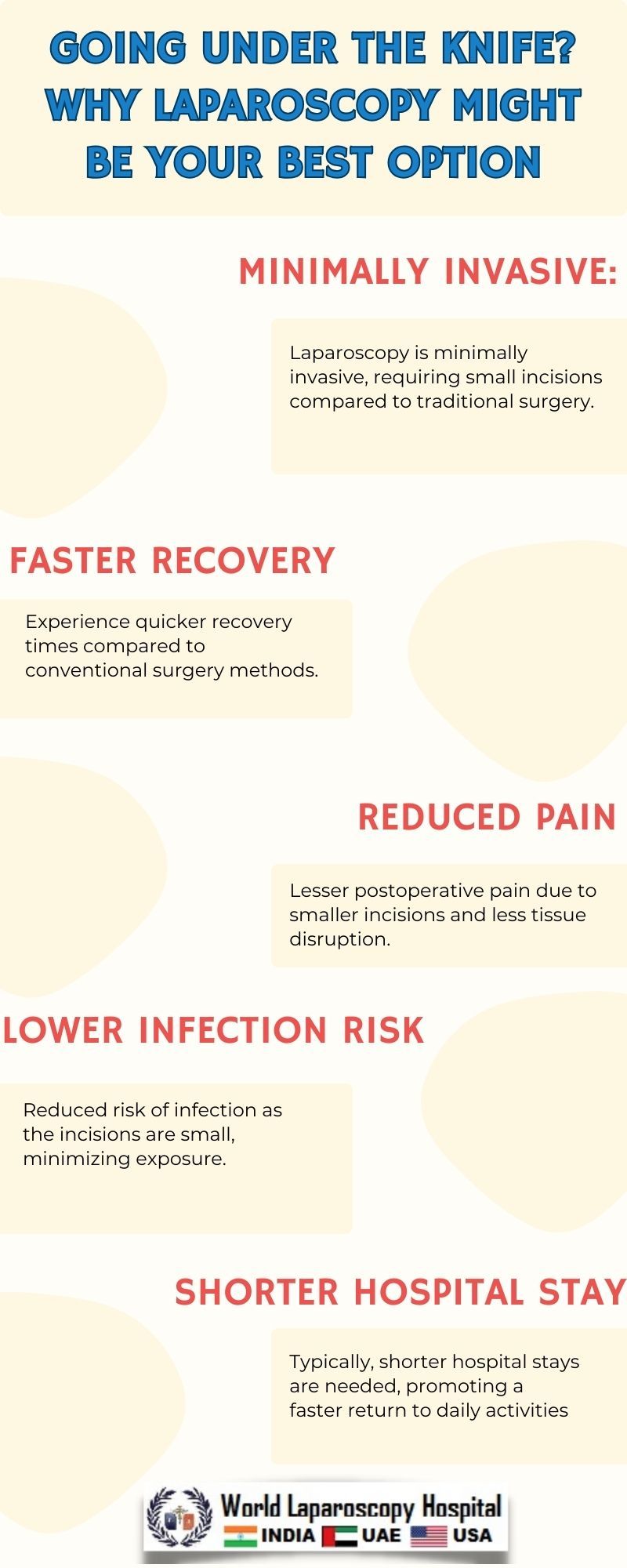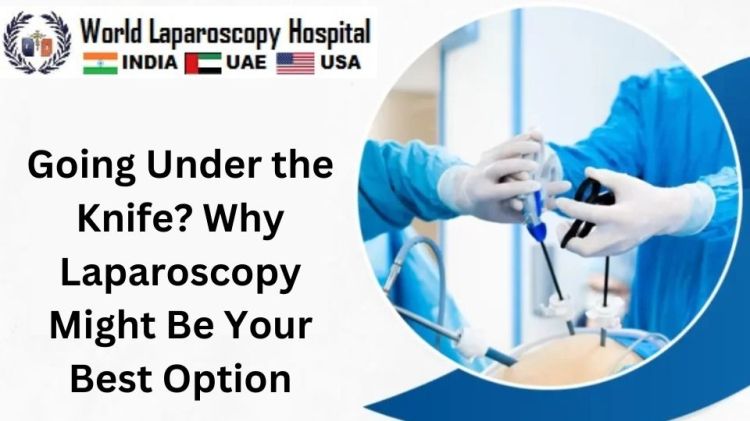Going Under the Knife? Why Laparoscopy Might Be Your Best Option
Introduction:
In the realm of surgical interventions, the choice between traditional open surgery and minimally invasive procedures is a crucial decision for both patients and surgeons. Among the various minimally invasive techniques, laparoscopy has emerged as a revolutionary option with unparalleled advantages. This article aims to provide a comprehensive exploration of laparoscopy, delving into its history, procedural aspects, benefits, and the diverse array of medical conditions it addresses.

Unveiling the Origins and Evolution of Laparoscopy:
Historical Perspective:
Laparoscopy has a rich history dating back to the early 20th century. Initially employed for diagnostic purposes, it has since evolved into a versatile surgical tool. The first successful laparoscopic procedure, a cholecystectomy, was performed in 1987 by Dr. Erich Mühe. This groundbreaking moment marked the inception of a new era in surgical innovation.
Technological Advancements:
The evolution of laparoscopy has been closely intertwined with technological progress. From the initial rigid instruments to the development of flexible endoscopes and advanced robotic systems, the field has continually advanced, enhancing precision and expanding the scope of laparoscopic surgeries.
Understanding the Laparoscopic Procedure:
Key Components:
Laparoscopy involves the use of a specialized instrument called a laparoscope, equipped with a high-resolution camera. This device is inserted through small incisions, allowing surgeons to visualize the internal organs on a monitor. Additional ports provide entry points for other surgical instruments, enabling the completion of various procedures.
Anesthesia and Incisions:
Unlike traditional open surgery, laparoscopy typically requires only general anesthesia. The surgeon makes small incisions—usually ranging from 0.5 to 1.5 centimeters—through which the laparoscope and other instruments are introduced. This minimizes trauma to surrounding tissues and accelerates postoperative recovery.
The Surgeon's Perspective:
Laparoscopy demands a high level of skill and precision from surgeons. Operating via a monitor, they navigate the instruments with precision, relying on hand-eye coordination. Training and experience are paramount, ensuring the surgeon can efficiently manipulate the tools within the confined space of the body.
The Multifaceted Benefits of Laparoscopy:
Quicker Recovery and Shorter Hospital Stays:
One of the hallmark advantages of laparoscopy is the expedited recovery it offers. Patients often experience less pain and discomfort, enabling them to resume normal activities sooner. Additionally, the shorter hospital stays associated with laparoscopic procedures contribute to cost-effectiveness and reduced strain on healthcare resources.
Minimal Scarring and Cosmetic Considerations:
Traditional open surgeries leave substantial scars, whereas laparoscopy's small incisions result in minimal scarring. This not only enhances the aesthetic outcome but also diminishes the risk of complications related to wound healing. The cosmetic benefits of laparoscopy are particularly relevant in elective procedures where patient satisfaction extends beyond medical outcomes.
Lower Infection Risk:
The reduced incision size in laparoscopy translates to a lower risk of postoperative infections. Smaller wounds are inherently less susceptible to bacterial infiltration, contributing to a decreased likelihood of complications. As infections pose a significant threat in surgical settings, this advantage underscores the importance of laparoscopy in minimizing such risks.
Improved Visualization and Precision:
The laparoscope's high-resolution camera provides surgeons with unparalleled visibility of the operative field. This enhanced visualization, coupled with precise instrument control, allows for meticulous procedures even in challenging anatomical locations. The magnified view aids in identifying and addressing issues that may be challenging in traditional open surgery.
Cardiovascular and Respiratory Benefits:
The minimally invasive nature of laparoscopy translates to fewer physiological disturbances. Patients undergoing laparoscopic procedures often experience less impact on cardiovascular and respiratory function. This is particularly advantageous for individuals with pre-existing cardiac or pulmonary conditions, making laparoscopy a safer option for a broader patient demographic.
Laparoscopy Across Medical Specialties:
Gynecology:
Laparoscopy has revolutionized gynecological surgeries, offering a minimally invasive approach to procedures such as hysterectomy, ovarian cyst removal, and tubal ligation. The benefits in terms of reduced pain, shorter recovery times, and improved fertility outcomes have positioned laparoscopy as the preferred choice in many gynecological interventions.
Gastrointestinal Surgery:
From cholecystectomies to colorectal procedures, laparoscopy has gained prominence in gastrointestinal surgery. The advantages of faster recovery and decreased postoperative complications make it an attractive option for conditions such as appendicitis, inflammatory bowel disease, and diverticulitis.
Urology:
Laparoscopy has found application in urological surgeries, including nephrectomies, prostatectomies, and bladder procedures. Its precision and reduced invasiveness are particularly beneficial in preserving renal function and minimizing the impact on surrounding structures.
Orthopedics:
While primarily associated with soft tissue surgeries, laparoscopy has made inroads into orthopedic procedures. Techniques such as arthroscopy enable joint examination and repair with minimal trauma, contributing to quicker rehabilitation and improved patient outcomes.
General Surgery:
Laparoscopy's versatility extends to various general surgical procedures, such as hernia repair, appendectomy, and splenectomy. The adaptability of laparoscopic techniques makes them applicable across a broad spectrum of surgical interventions, fostering its integration into routine surgical practice.
Potential Challenges and Considerations:
Learning Curve for Surgeons:
Despite its numerous advantages, laparoscopy requires surgeons to undergo specialized training due to the inherent challenges of operating through small incisions. The learning curve can be steep, and proficiency is crucial for optimizing outcomes. Continuous education and skill refinement are essential components of successful laparoscopic surgery.
Equipment Costs:
The acquisition and maintenance costs of laparoscopic equipment, including high-quality cameras and precision instruments, can be substantial. While the long-term benefits often justify the investment, these financial considerations are vital for healthcare institutions and practitioners contemplating the integration of laparoscopy into their practices.
Patient Selection:
Not all patients are suitable candidates for laparoscopy, and careful consideration must be given to individual medical histories and conditions. Factors such as obesity, severe adhesions from previous surgeries, or anatomical complexities may necessitate a traditional open approach.
Future Trends and Innovations in Laparoscopy:
Robotics in Laparoscopic Surgery:
The integration of robotic systems has ushered in a new era of precision in laparoscopic surgery. Robotic-assisted procedures provide enhanced dexterity, three-dimensional visualization, and improved ergonomics for surgeons. As technology continues to advance, the role of robotics in laparoscopy is likely to expand, further refining surgical capabilities.
Single-Incision Laparoscopy:
Emerging as a frontier in minimally invasive surgery, single-incision laparoscopy aims to further reduce the invasiveness of procedures by utilizing a single entry point. While still in its nascent stages, this technique holds promise for minimizing scarring and optimizing patient satisfaction.
Artificial Intelligence (AI) Integration:
AI applications in laparoscopy are poised to enhance diagnostic and procedural aspects. From image recognition for pathology identification to real-time feedback for surgeons, AI holds the potential to augment the precision and efficiency of laparoscopic interventions.
Conclusion:
In conclusion, laparoscopy stands as a transformative force in the landscape of surgical interventions. Its evolution from a diagnostic tool to a versatile surgical technique underscores its adaptability and success in diverse medical specialties. As technology continues to propel advancements in laparoscopy, patients and surgeons alike can anticipate even greater precision, reduced invasiveness, and improved outcomes. With its multifaceted benefits ranging from quicker recovery to enhanced visualization, laparoscopy undoubtedly represents a pinnacle in the pursuit of surgical excellence. As the future unfolds, the journey "under the knife" is set to become increasingly synonymous with the precision and finesse afforded by laparoscopic innovation.






